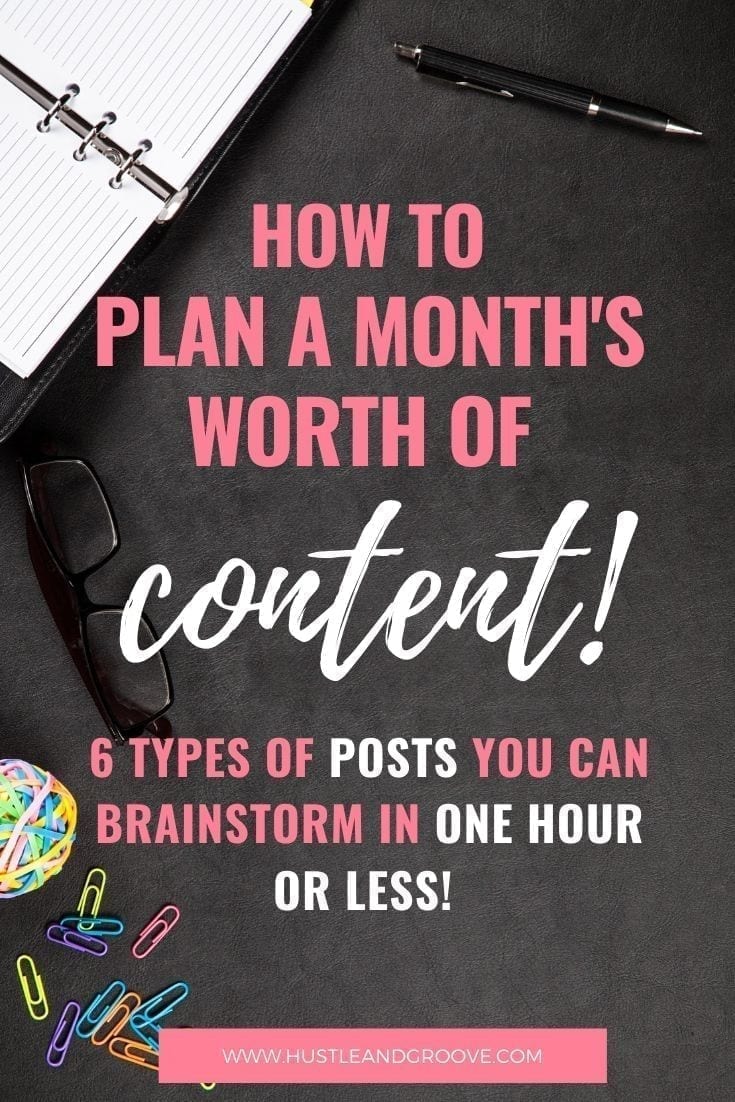Alright, bloggers… are you struggling to come up with a month’s worth of content?
Raise your hand if you always know what articles you’re going to write and when you’re going to write them.
As I look around the imaginary digital room, I see very few hands raised. 
Whether it’s just writer’s block or you feel you’ve written on a subject one too many times before, it can be tough to decide what to write next.
That’s why you should plan out your content in advance — particularly if you’re blog writing.
Now, you may be asking, “If I can’t figure out what to write now, how can I figure out a whole month’s worth of content?”
I’m telling you it can be done, and you can accomplish it all in under an hour!
What’s the secret?
There’s really only one thing you need to figure out before you can start planning out your content…
What kind of transformation do you want your readers to experience?
For example, if you’re a food blogger, maybe you want to spend the next month helping busy parents start serving at least five home-cooked meals every week. Or, if you’re a book marketing blogger like me, maybe you want to teach authors how to take a book they’ve written and self-publish it on Amazon.
Then, once you know where you want to take people, planning out a month’s worth of content is surprisingly simple.
In short, you just need to work backwards from the destination and give your readers everything they’ll need to reach it.
Here are the 6 types of articles you’ll probably want to include in your one-month content plan.
Table of Contents
6 Types of Articles to Include in A Month’s Worth of Content
1. “How To” Articles
It’s hard to accomplish anything if you don’t know how. How To posts are where you solve that problem for your readers. For example, let’s say you’re helping readers self-publish their first book. You’ll want to have at least one How To article explaining the steps, but you might break the process up into several articles.
To use my other example, if you’re trying to help readers start eating 5 home-cooked meals per week, you’ll probably want lots of How To articles around topics like how to meal plan, how to cook freezer meals, how to reheat rotisserie chicken so it tastes as good as the first time… You get the idea.
Just like that, you already have at least one article idea, and we’re just getting started.
2. “What If” Articles
Almost no plan is truly one size fits all. We each have special circumstances that require us to customize even the best How To advice to our own lifestyle. That’s what makes “What If” articles so valuable. These are where you respond to the questions your readers are asking (or that you imagine they will be asking).
Using the home-cooked meals example:
- What if my kids have food allergies?
- What if I only have 30 minutes a day to prepare food?
- What if I’m on a diet and my spouse doesn’t want to eat weight loss food?
- What if I can’t afford to buy ingredients in bulk right now?
Using the self-publishing example:
- What if I’m not tech savvy at all?
- What if I’m writing under a pen name?
- What if I don’t know how to design a book cover?
- What if I’m on a very tight budget?
Each of these is an article idea that supports the How To posts from earlier. Individual What If posts won’t apply to everyone, but writing a few of them toward common questions is a great way to serve your readers and build out your content calendar.
3. Mindset Articles
It’s one thing to know what to do. It’s another to make it happen. What holds us back? Often, it’s limiting beliefs.
Perhaps your reader wants to become a self-publisher. They’ve got their book ready to go, and all they’ve gotta do is push that button. But something is keeping them from moving forward.
Maybe they’re scared they aren’t a good enough writer to share their book with the world.
To help, you could write an article called, “Why You Don’t Have to be a Perfect Writer to Tell an Amazing Story.”
Or maybe your readers have a limiting belief that their kids will complain about home-cooked meals, and preparing those meals will be a big waste of time.
You could write an article about the research behind kids learning to like new foods after repeated tries.
Your goal is to identify the limiting beliefs that might keep readers from implementing your How-To advice — and then replace those faulty beliefs with encouraging truths.
As for how to actually write a Mindset article, check out Lise’s post about how to control your fear through awareness. It’s a terrific example.
4. Getting Started Articles
The hardest part of any journey is getting started. That’s why you might want to offer extra help for this stage.
Let’s say self-publishing a book is a 7 step process — all covered in your How To article(s).
You might want to take that very first step and break it down into even smaller steps, giving the reader an easier path forward.
Or maybe you’ll want to offer some prerequisite steps for people who are just starting out. For example, your how to self-publish a book series might benefit from a “how to write a book in the first place” article or a post about “how to title a book.”
You’re just slowing things down a bit so no one gets left behind or intimidated.
5. Encouragement Articles
It’s not always easy to complete a new journey in life.
As a matter of fact, it’s usually quite difficult. And many times, we need a little support to get us through it.
You can be that anchor!
A post here or there motivating your readers could be just what’s needed.
You might write an article called “Why becoming a self-published author is worth it.” Or “Why you shouldn’t feel bad on days when a home-cooked meal just isn’t possible.”
Articles like these help your readers to not give up, making it possible for them to reach the destination.
6. Product Suggestion Articles
The right tools make everything easier. And you can help readers discover which products could aide them on their journey.
So in the home-cooked meals example, you might want to talk about meal delivery services, which send clear recipes along with pre-portioned ingredients every week. An article comparing the prices and features of these meal kit services would help your readers choose the right option for their family, thus helping them reach the goal of eating 5 home-cooked meals per week.
In the self-publishing example, you might want to offer an article about the best software for authors — tools for cover design, editing, formatting, marketing, etc.
Pro Tip: When you write product suggestion articles, see if any of the tools you’re recommending have affiliate programs you can join. Then you can earn commissions on the sales that come from your articles.
How’s Your Content Calendar Looking?
If you’ve been following along, thinking of article ideas for each of the 6 categories I’ve mentioned, you’re probably already sitting on a full month’s worth of content right now. As a matter of fact, you may be thinking you’ve got too many ideas.
And that’s a great problem to have.
You’re also creating content more intentionally. You have a specific goal in mind instead of just publishing posts at random.
That’s another reason I love this approach to content planning (a big thanks to my friend Kyle for introducing me to it and encouraging me to share it).
Now it’s time for you to start writing!
Cheers!
[img_text_aside style=”2″ image=”https://hustleandgroove.com/storage/2019/11/Dave-Profile-Pic.jpg” image_alignment=”left” headline=”Dave%20Chesson%20%7C%20Kindlepreneur” alignment=”left”]”Dave Chesson is the creator of Kindlepreneur.com, a website devoted to teaching advanced book Marketing which even Amazon KDP acknowledge as one of the best by telling users to “Gain insight from Kindlepreneur on how you can optimize marketing for your books.” Having worked with such authors as Orson Scott Card, Ted Dekker and more, his tactics help both Fiction and Nonfiction authors of all levels get their books discovered by the right readers.”
[/img_text_aside]


